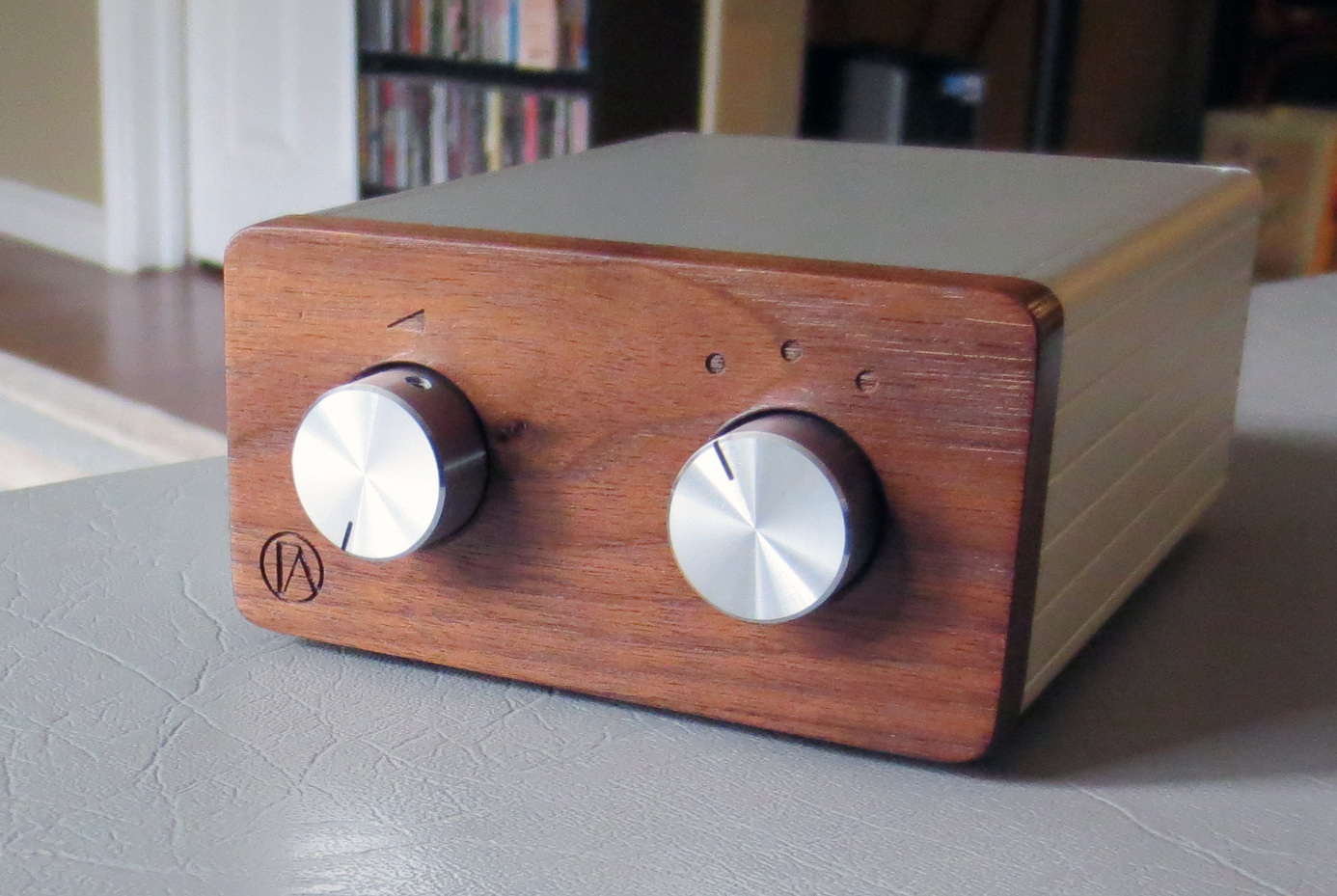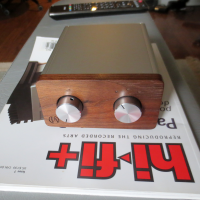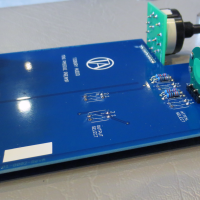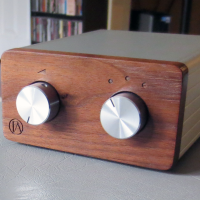Review by Noam Bronstein
A “passive preamp” is basically a volume control and switchbox – it has no active circuitry. You don’t plug it into the electrical grid, or feed it batteries. So it would more correctly be called a control unit, than a preamp: it doesn’t “amplify” anything. Yet as most audio folks know, passive solutions can often be desirable – and even elegant (for example: speaker crossovers, step-up transformers, and autoformers…the latter two actually do increase voltage gain, but don’t require their own electrical supply).
There could be many reasons for using a passive preamp. For one: it generally costs less. Maybe you were using an integrated, and decided to trade up for a sweet deal on a power amp. And, whoops, you forgot to budget enough for the active preamp and extra interconnect. Passive pre’s, arguably, can be viewed as a more purist route, as well – more like the proverbial “straight wire with (no) gain”. Art Dudley just reviewed a passive pre that sells for $12,000. Many of today’s “integrated amps” are really power amps with a volume pot and no active preamp circuit. As far as the purist thing, this is one of those old debates in audio circles, which I won’t attempt to try and untangle here.
Heck, maybe you’ve had dozens of active preamps and you’re just curious about passives. With source components like CD/DAC typically putting out 2V, most systems today have an abundance of gain. So the option to use a passive is there to explore.
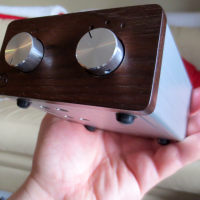 Enter Tisbury Audio, a shop out of London, England. Their little Mini II sells for the princely sum of £129 (about $200), is nicely built, looks good, and works extremely well. When I heard about it, I wanted to try it out – I’ve had several passive attenuators in my past (and present), but the last time I tried a commercial unit was back around 1999; and my memories of that model (the Creek OBH-12) were not very positive ones.
Enter Tisbury Audio, a shop out of London, England. Their little Mini II sells for the princely sum of £129 (about $200), is nicely built, looks good, and works extremely well. When I heard about it, I wanted to try it out – I’ve had several passive attenuators in my past (and present), but the last time I tried a commercial unit was back around 1999; and my memories of that model (the Creek OBH-12) were not very positive ones.
When I opened the package, I was very pleased with the finish and build quality. This unit isn’t quite small enough to hold in your hand, but it is diminutive. Still, the rotary knobs are adequately sized and have a decent feel, and the Mini II looks like a real piece of audio gear, not a toy. It makes my homemade attenuator look ugly by comparison.
I inserted the Mini II in front of several different tube amps, with excellent results. Used in its simplest mode, it does exactly what it should – attenuate the gain, and nothing else. But the Tisbury also provides you the ability to switch between three different inputs, and, in a very nice touch, offers two outputs. So that connecting a powered subwoofer is easily accomplished. I don’t have a sub at the moment, so I didn’t try it. Output 2 is actually fully configurable, so that it can be used as variable or fixed – or removed from the signal path altogether. This is done via dip switches which are accessible via two holes in the bottom plate of the chassis.
The ‘watchout’ with passive units is to run interconnects as short as reasonably possible. However, this concern tends to be overblown by a few whistleblower types. A meter or two is generally fine, five meters may start to get you into problems. This is dependent on capacitance and impedance factors, but it’s a general rule to follow. If music starts to sound less fleshy, less dynamic, bass shy, etc., that indicates a mismatch between the passive and your system / cables. As I said, I’ve never had this happen, except once, many years ago with the Creek, and I don’t recall all the circumstances anymore. Wes Young from Tisbury noted that their FAQ says cables up to 10 meters are OK, and explains, “One of the bonuses of our stepped attenuator is it’s less susceptible to cable problems than some others (due to relatively low worst case output impedance). It varies with the volume setting from 0 Ohms to maximum 2.5 kOhms (though most settings are well below that), so roll off is a non-issue in most systems. It’s the passives with >10 kOhms input impedance or that use a “shunt” attenuator where cables become a real issue, as their maximum output impedance is often over well 10 kOhms.”
Tisbury’s unit indeed uses a discrete resistor arrangement for the volume attenuator – the control uses incremented “steps” that you can feel, and which are also very handy for setting repeatable levels (though the Mini II doesn’t have markings on the wooden face). From an audio signal perspective, in essence it means that only one or two resistors are ever engaged in the circuit path. A very good thing – and generally a major improvement in transparency over the cheap ‘wiper’ potentiometers found in many volume control designs.
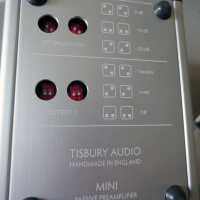 A semi-common gripe with resistor attenuators is that they don’t have enough attenuation – that the steps are too few or too close together. This can mean, for example, that a good setting can’t be found for late-night listening, and people trying to sleep are disturbed. On the other hand, if the steps are too far apart, you lose fine control and can easily end up without the choice of a happy midpoint between a step that’s too loud and one that’s too soft. Tisbury has handled this issue with a variable arrangement – again, dip switches allow the user to customize whether he or she wants -10dB, -20dB, or even 0dB of attenuation. In my view, this is an excellent approach, and it’s the kind of design choice that gives Tisbury the flexibility to manufacture one unit that serves 99.9% of prospective buyers.
A semi-common gripe with resistor attenuators is that they don’t have enough attenuation – that the steps are too few or too close together. This can mean, for example, that a good setting can’t be found for late-night listening, and people trying to sleep are disturbed. On the other hand, if the steps are too far apart, you lose fine control and can easily end up without the choice of a happy midpoint between a step that’s too loud and one that’s too soft. Tisbury has handled this issue with a variable arrangement – again, dip switches allow the user to customize whether he or she wants -10dB, -20dB, or even 0dB of attenuation. In my view, this is an excellent approach, and it’s the kind of design choice that gives Tisbury the flexibility to manufacture one unit that serves 99.9% of prospective buyers.
When I opened up the Mini II for a look (and photos), I was again very impressed. The layout is clean and simple, and the parts all appear to be of high quality, as does the circuit board and soldering. I’d wager that with a little care in handling, this unit could be expected to last forever. If one handles the RCA jacks and dip switches attentively, there really isn’t anything in the Mini II that can fail (the warranty is one year).
Sonics, you ask. Have you ever wanted to put a level control on your power amp? Or an extra input, with a switch to select between them? If so, did you expect it to have a sound? That’s basically what we’re dealing with here. Music flowed through this passive, and I heard nothing additive or subtractive as a result. This is a good thing! Now I know, that some setups “need” an active preamp to sound right. For that matter, some people just want a remote control. So obviously, a minimalist passive like this may not be the right solution for everyone, or every system. But I think that from a sonic pov, it will work well in a good majority of systems. In fact, the “sound of your interconnects” may be an issue, or potentially a more noticeable issue, by using a control unit that by and large, “does nothing”. 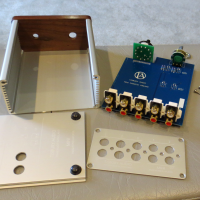
I would recommend the Tisbury Mini II to almost anyone who’s looking for a simple, effective control solution that doesn’t colour or distort their music. It’s sold directly over the web, and priced very reasonably. It can enhance the experience or usability of most any system. Give it a try!
Tisbury Audio Mini II Passive Preamplifier, £129 plus shipping
Web: http://www.tisburyaudio.co.uk/

